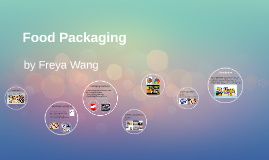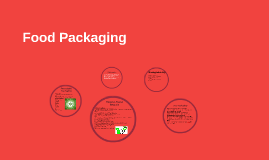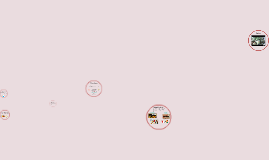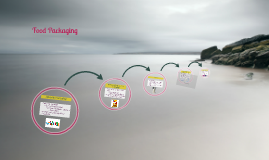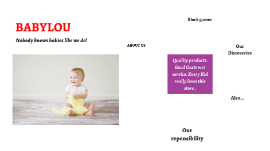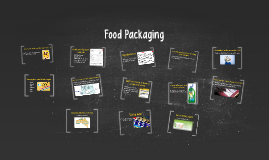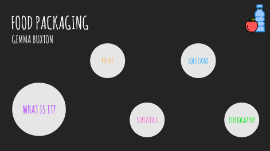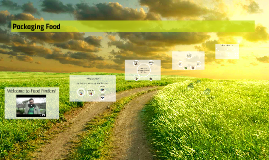Food Packaging
Transcript: FOOD PACKAGING GEMMA BUXTON FOOD PACKAGING WHAT IS IT? Food packaging is defined as enclosing food to protect it from tampering or contamination from physical, chemical, and biological sources. From: Gases in Agro-Food Processes, 2019 TYPES OF FOOD PACKAGING TYPES Grocery store food is typically sold in glass, metal, plastic or cardboard containers, and often comes encased in multiple layers. Those containers are then placed into plastic or paper grocery bags. Takeout food is often wrapped in plastic or aluminum foil, then placed into paper, plastic or containers, and is put into paper bags and finally into plastic grocery bags. These bags may contain plastic cutlery, napkins and straws, as well. Processed food often has multiple layers of packaging; for example, a food item might be placed in a tray, covered in paper or plastic wrap, placed into a cardboard box and then, often, covered again in plastic wrap. WHAT ARE THE RISKS? RISKS Packaging can potentially make food unsafe or unsuitable, for example if: something contaminates food during the packaging process harmful microorganisms get into food from dirty or damaged packaging parts of the packaging break off into food (e.g. glass or plastic fragments) chemicals leak from packaging into food. IMPACTS ON THE ENVIRONMENT ISSUES Most packaging is designed as single-use, and is typically thrown away rather than reused or recycled. According to the Environmental Protection Agency (EPA), food and food packaging materials make up almost half of all solid waste. TYPES AND AFFECTS OF FOOD PACKAGING MATERIALS GLASS Air emissions result from combustion of fuels include greenhouse gases, sulfur oxides and nitrogen oxides Emissions that result from vaporization and recrystallization of feedstock material include fine particulates that can contain heavy metals such as arsenic and lead ALUMINUM Uses a lot of water and creates a toxic mixture that may contain radioactive elements or heavy metals Emissions include greenhouse gases, sulfur dioxide, dust, and waste water PAPER & CARDBOARD Mills use a lot of energy and water; in the past, this produced large volumes of toxic waste water. Air emissions include carbon monoxide, sulfur dioxide, nitrogen oxides, volatile organic compounds and particulates. PLASTICS There are seven types of plastics polymers that account for 70 percent of all plastics production, including: polypropylene, polystyrene, polyvinyl chloride, polyethylene terephthalate and polyethylene, all of which are derived from fossil fuels and are used in food packaging Takes 40 years to break down The Impact of Food Packaging on Birds and Marine Mammals BIRDS & MARINE MAMMALS Food packaging spreads out to the far reaches of our planet, litter from food packaging poses a threat to marine life and birds; plastic is the worst offender, by far. Of all the coffee cups and lids, coffee pods, straws, Styrofoam containers, plastic bottles and their caps, plastic wraps, six-pack holders and plastic grocery bags, most is designed for single use. If it isn’t recycled, it often clogs our waterways, where animals mistake it for food or get tangled in it. Water and Land Pollution from Food Packaging WATER & LAND After it is used, most packaging is discarded and is either buried in a landfill or becomes litter that is carried along by wind and water currents into the environment. Packaging sent to landfills, especially when made from plastics, does not degrade quickly or, in some cases, at all, and chemicals from the packaging materials, including inks and dyes from labeling, can leach into groundwater and soil. The severe impacts of plastic on the environment are not limited to ocean pollution. It is estimated that one third of all discarded plastic ends up in soil or in freshwater. STATISTICS STATISTICS Australians throw away around 1.9 million tonnes of packaging each year – enough to fill the Melbourne Cricket Ground nine times over. Sixty percent of all packaging is for food products. Australia uses over 10 million plastic bags a day – plastic bags are causing huge problems in our oceans 85% of soft plastics from bags and packaging ends up in landfill SOLUTIONS PROGRAMS IMPLEMENTED TO SOLVE THIS ISSUE PROGRAMS Food Print - https://foodprint.org Food Standards - https://www.foodstandards.gov.au Sustainability Victoria - https://www.sustainability.vic.gov.au/ Environment Victoria - https://environmentvictoria.org.au/ What CAN YOU DO? WHAT YOU CAN DO? Grow your own food Cook at home, BYO containers Use reusable packaging Make a shopping list Look for foods will little to no packaging Say no to straws and plastic bags Buy products in reusable packaging Buy products made from recycled materials Recycle BIBLIOGRAPHY BIBLIOGRAPHY Center for Biological Diversity. “Oceans Plastic Pollution: A Global Tragedy for Our Oceans and Sea Life.” Center for Biological Diversity, n.d. Retrieved March 7, 2019, from http://www.biologicaldiversity.org/campaigns/ocean_plastics/ Winn, Patrick.






